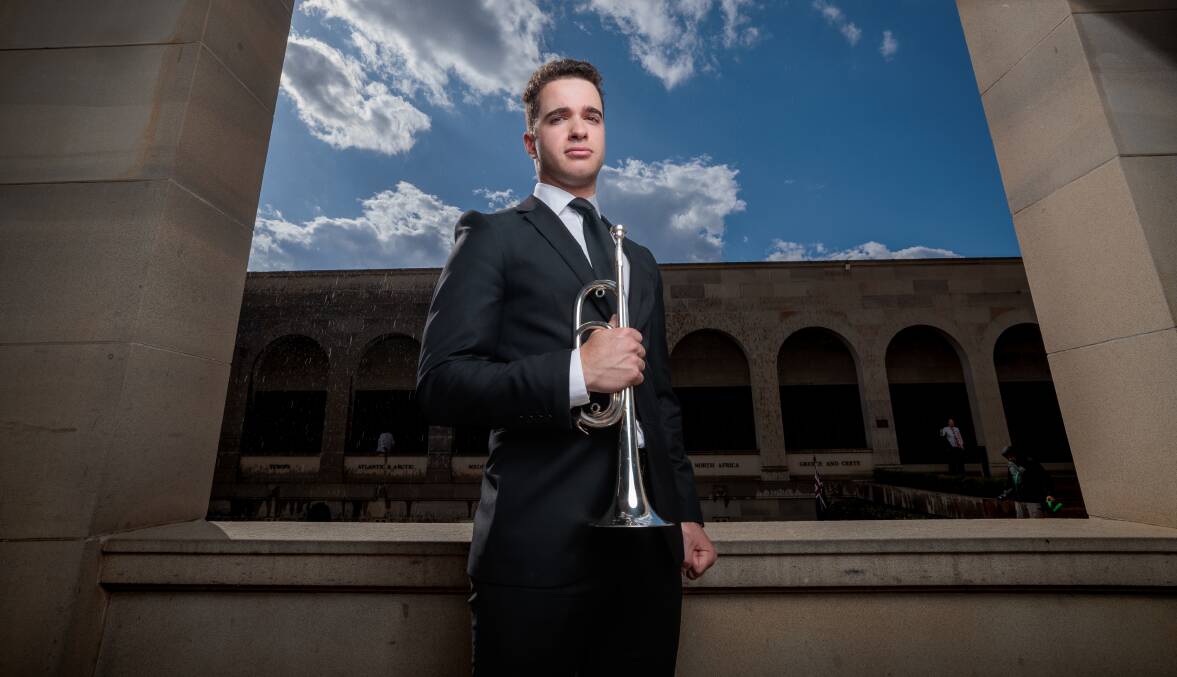The first surprise is that the Australian War Memorial's youngest ever bugler is not a military man.
The second is that Jackson Boyd is a fan of heavy metal, a music as different from the gentle sweetness of his performances of the Last Post as granite is from silk.
As he performs in the twilight at the daily ceremonies at the memorial, he stands ram-rod straight, his left hand clenched (and drenched in the current downpours). His back arches backwards like a sentry's.
Rather than being a genuine military sentry, he is a student at the ANU, recruited to the memorial's corps of buglers when he was 15 and a schoolboy at Alfred Deakin High School in Canberra. He applied when he was 14 but had to wait until his 15th birthday under the AWM bugling rules.
But he's impressive. He has the right military demeanour for the ceremony. He marches in step for his exit at the end. He looks the part.

And he has nerves of steel - or, rather, he seems to. He actually says that he is nervous, playing solo to absolute silence.
"It's very nerving," he said, but the way around nerves was practice. "If you practise enough, even if you get a bit wobbly, you can still play it well," he said.
"It's very exposing because you can't hide behind an orchestra if you split a note."
Nervous, he may be, but he is also moved emotionally when he plays the Last Post at the national shrine of remembrance. "It's definitely not just another tune. It's a big honour to sound the Last Post at the Australian War Memorial".
The piece was first published in the 1790s. It came to signify the end of a day and the end of a battle as a signal to the wounded and lost to return towards the bugle.
Jackson is the youngest bugler - but the Last Post ceremony has only been going at the Australian War Memorial for a decade. The first such ceremony was on April 17, 2013 so it counts as what some historians call "invented tradition".
It is now embedded in the daily routine of the Memorial, starting at 4.45pm, though soon to move 15 minutes earlier to 4.30pm. Each ceremony involves the reading of an account of the life and sacrifice of a veteran, culminating in the sounding of the Last Post.
The Last Post is "sounded" rather than "played". It is a piece of music but its function is as a military signal. And the word "sounded" suits the somberness of a ceremony remembering the dead.
Jackson reckons he's played before a thousand people at times. "It feels very important to play," he said. "Every ceremony is moving, especially the First and Second World War ones, but one of the most moving for me was when the memorial honoured an Afghanistan veteran and his whole family was gathered there."
He started playing the trumpet in Year 5 at Garran Primary School. He said he got involved in what he called the marvellous ACT Instrumental Music Program which aims to have a brass or woodwind band in every Canberran public school.
From the trumpet, it's a short step to the bugle (which is a simplified version of a trumpet). He found himself playing the Last Post in high school and then his father got wind of the need for buglers at the war memorial.
"One of my trumpet teachers was a bugler, and she told me about it. I told my dad and, without my knowledge, he organised an audition when I was 14.
"The audition went well but I had to wait six months because I couldn't start until I was 15."
His favourite music? "I actually like rock: AC/DC".







